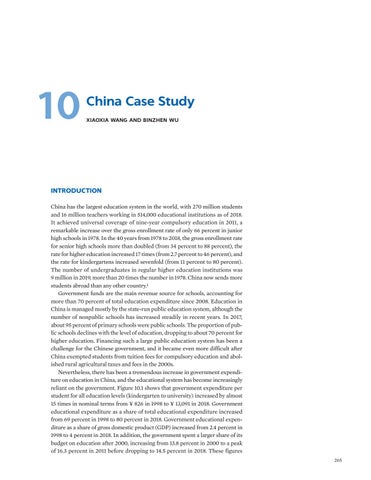10
China Case Study XIAOXIA WANG AND BINZHEN WU
INTRODUCTION China has the largest education system in the world, with 270 million students and 16 million teachers working in 514,000 educational institutions as of 2018. It achieved universal coverage of nine-year compulsory education in 2011, a remarkable increase over the gross enrollment rate of only 66 percent in junior high schools in 1978. In the 40 years from 1978 to 2018, the gross enrollment rate for senior high schools more than doubled (from 34 percent to 88 percent), the rate for higher education increased 17 times (from 2.7 percent to 46 percent), and the rate for kindergartens increased sevenfold (from 11 percent to 80 percent). The number of undergraduates in regular higher education institutions was 9 million in 2019, more than 20 times the number in 1978. China now sends more students abroad than any other country.1 Government funds are the main revenue source for schools, accounting for more than 70 percent of total education expenditure since 2008. Education in China is managed mostly by the state-run public education system, although the number of nonpublic schools has increased steadily in recent years. In 2017, about 95 percent of primary schools were public schools. The proportion of public schools declines with the level of education, dropping to about 70 percent for higher education. Financing such a large public education system has been a challenge for the Chinese government, and it became even more difficult after China exempted students from tuition fees for compulsory education and abolished rural agricultural taxes and fees in the 2000s. Nevertheless, there has been a tremendous increase in government expenditure on education in China, and the educational system has become increasingly reliant on the government. Figure 10.1 shows that government expenditure per student for all education levels (kindergarten to university) increased by almost 15 times in nominal terms from ¥ 826 in 1998 to ¥ 13,091 in 2018. Government educational expenditure as a share of total educational expenditure increased from 69 percent in 1998 to 80 percent in 2018. Government educational expenditure as a share of gross domestic product (GDP) increased from 2.4 percent in 1998 to 4 percent in 2018. In addition, the government spent a larger share of its budget on education after 2000, increasing from 13.8 percent in 2000 to a peak of 16.3 percent in 2011 before dropping to 14.5 percent in 2018. These figures 265






